FEAR AND DYSTOPIA VIA MODERNISM AND TECHNOLOGY:
▪ page 1:
The Black Cat ▪ Alphaville ▪ True Stories
page 2: A Clockwork Orange ▪ Brazil
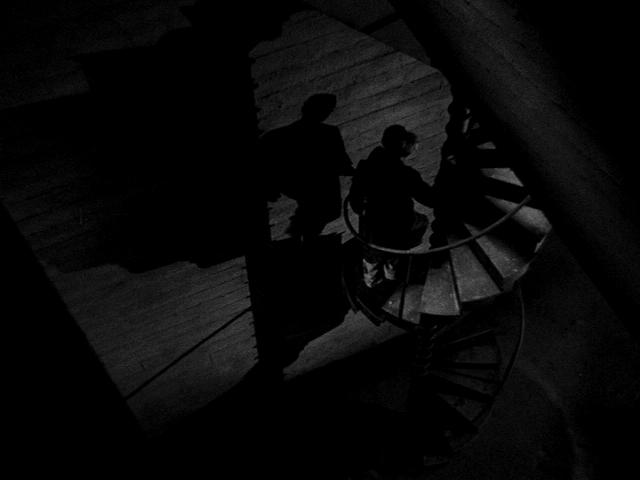 The environment created in The Black Cat (Ulmer 1934) lies somewhere between the deliberately real and unreal. The Black Cat is not set in an urban environment, but in one very remote ultra-modern house. The location is fictitious, like Caligari and Sin City, but the story is firmly rooted in European culture and history. Two opposing architectural styles are presented, the pure modern house above and the prison below - neither are new inventions in architectural form, but neither are traditional living environments.
The environment created in The Black Cat (Ulmer 1934) lies somewhere between the deliberately real and unreal. The Black Cat is not set in an urban environment, but in one very remote ultra-modern house. The location is fictitious, like Caligari and Sin City, but the story is firmly rooted in European culture and history. Two opposing architectural styles are presented, the pure modern house above and the prison below - neither are new inventions in architectural form, but neither are traditional living environments.
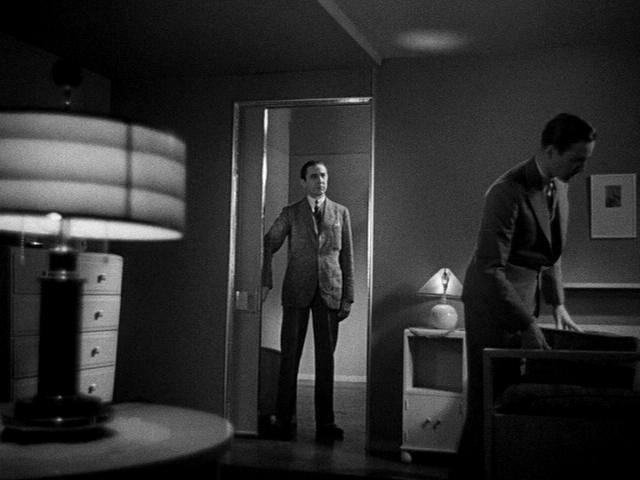 There is a perceived link between traditional architecture and traditional happiness, particularly in the domestic realm (Rosa 2000), which is built upon in the film by introducing a happy newlywed couple into the uncomfortable environment of a modern home, complete with a distinctly unnatural host. Modern architect Poelzig is the villain of the film, and his house is a relentlessly modern composition as sleek, hard, cold and uncompromising as he is. The film was criticized for satirizing European architecture (Neumann 1999) however the identification of a modern home with a deviant personality is not unique to The Black Cat.
There is a perceived link between traditional architecture and traditional happiness, particularly in the domestic realm (Rosa 2000), which is built upon in the film by introducing a happy newlywed couple into the uncomfortable environment of a modern home, complete with a distinctly unnatural host. Modern architect Poelzig is the villain of the film, and his house is a relentlessly modern composition as sleek, hard, cold and uncompromising as he is. The film was criticized for satirizing European architecture (Neumann 1999) however the identification of a modern home with a deviant personality is not unique to The Black Cat.
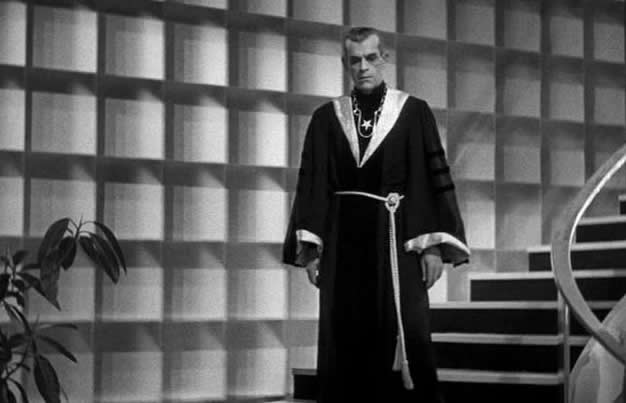 “In recent Hollywood movies, modern domestic architecture has become identified almost exclusively with characters who are evil, unstable, selfish, obsessive, and driven by pleasures of the flesh… Bad guys may no longer wear black, but they do live in white-walled modern houses.”
“In recent Hollywood movies, modern domestic architecture has become identified almost exclusively with characters who are evil, unstable, selfish, obsessive, and driven by pleasures of the flesh… Bad guys may no longer wear black, but they do live in white-walled modern houses.”
– Joseph Rosa, 2000
In the house, a feeling of discomfort is created with uncomfortable angles, subtly echoing the techniques of Caligari: both sets are constructed to represent veiled violence and psychological traps, and both convey a sense of distortion – of plot and of character - through the environment of the film. However, to intensify the horror produced in The Black Cat, the action retreats to an environment which creates a stereotypical sense of discomfort: the gravest sins and most violent scenes are not set in the house, but in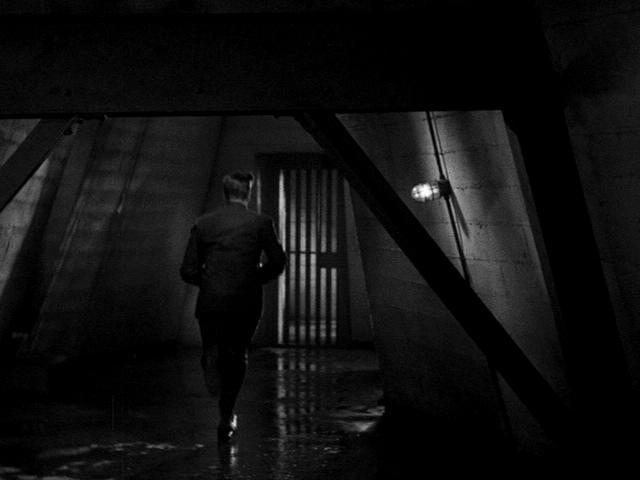 the prison below where satanic rituals, murder and torture occur amid rough concrete walls and iron bars. Like the sets of Caligari, the prison is a nightmarish place of menacing angles, dark corners, confined spaces, rough and jagged surfaces – designed to suggest danger and create fear. There are also scenographic similarities between the prisons of The Black Cat and Sin City, most notably the walls of lovely female corpses mounted like trophies.
the prison below where satanic rituals, murder and torture occur amid rough concrete walls and iron bars. Like the sets of Caligari, the prison is a nightmarish place of menacing angles, dark corners, confined spaces, rough and jagged surfaces – designed to suggest danger and create fear. There are also scenographic similarities between the prisons of The Black Cat and Sin City, most notably the walls of lovely female corpses mounted like trophies.
“At a time when films often promoted modern architecture as a major attribute of fast-paced, modern life, here it became a distinctive feature of European decadence, a direct result of the horrors of World War I.”
- Neumann 1999, p 116
The treatment of architectural environments in The Black Cat falls between the techniques of Caligari and Alphaville (Godard 1965), as the evil Poelzig exists between the jagged darkness of the prison and the clean-lined, brightly-lit modern house. The discomfort suggested by the harsh lighting and smooth surfaces of modern architecture, all hardness and coldness, give the style a sinister potential which makes it plausible as an environment for fear or dystopia: modern architecture can be construed as a habitat which is not quite human. Director Jean Luc Godard exploits this potential, casting modern architecture as oppressive and unfeeling in Alphaville.
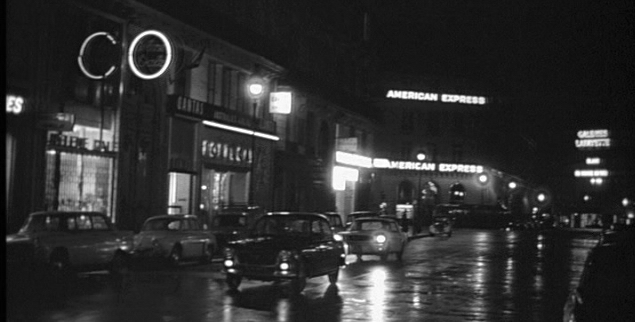 “Godard … has made a film that asks its audience to take downtown Paris as the center of the galaxy by eliminating all special effects and simply shooting the film in the nocturnal, fluorescent and neon lit interiors of hotels and office buildings.”
“Godard … has made a film that asks its audience to take downtown Paris as the center of the galaxy by eliminating all special effects and simply shooting the film in the nocturnal, fluorescent and neon lit interiors of hotels and office buildings.”
- Burton for Pif Magazine, 2006
Godard makes highly unconventional use of the urban environment in Alphaville (Burton 2006): the sets are entirely real, shot in the streets and buildings of contemporary Paris, but are not presented as 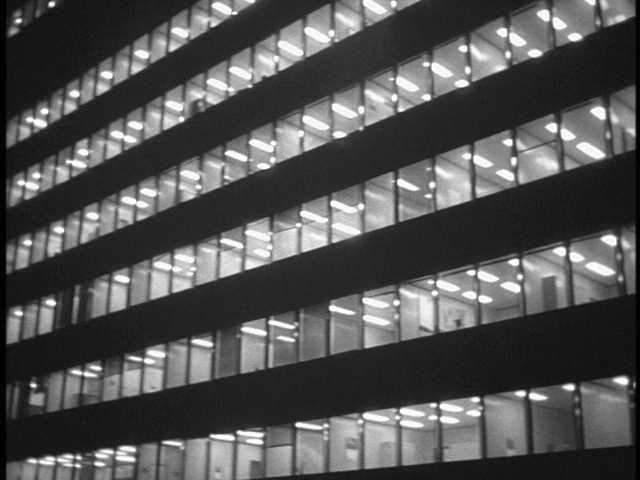 contemporary or as Paris. Instead, modern Paris is cast as Alphaville, centre of the universe, where a computer dictates emotionless existence in favor of cold logic. The streetscapes are filmed after dark, which eliminates any recognizable views of the historic city, but these scenes are not further enhanced with artificial backgrounds or futuristic props: Godard does not elaborate the sets of Alphaville with the usual accoutrements of science-fiction films.
contemporary or as Paris. Instead, modern Paris is cast as Alphaville, centre of the universe, where a computer dictates emotionless existence in favor of cold logic. The streetscapes are filmed after dark, which eliminates any recognizable views of the historic city, but these scenes are not further enhanced with artificial backgrounds or futuristic props: Godard does not elaborate the sets of Alphaville with the usual accoutrements of science-fiction films.
The sense of dystopia in Alphaville emerges from the plot, but is developed by Godard’s filming techniques in the presentation of the environment. The contrast between natural darkness and harsh artificial light, the focus on isolated objects such as signs and icons, and the choice of rigid modern architecture all enhance the credibility of this urban environment as locus of the dystopia described.
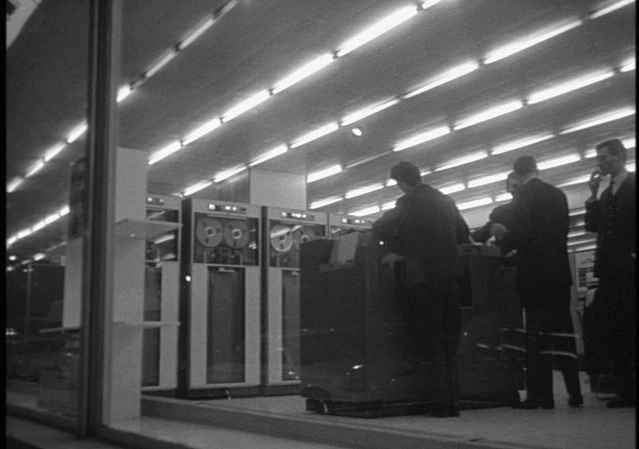 All of Alphaville is as physically unyielding- all slick modern materials and hard reflective surfaces - as it is socially inflexible. The sets identify the logical oppression of the master computer with the functional rationalism of modern architecture, in a spiritless society which becomes imprisoned in their modern buildings when the computer dictating their decisions fails.
All of Alphaville is as physically unyielding- all slick modern materials and hard reflective surfaces - as it is socially inflexible. The sets identify the logical oppression of the master computer with the functional rationalism of modern architecture, in a spiritless society which becomes imprisoned in their modern buildings when the computer dictating their decisions fails.














